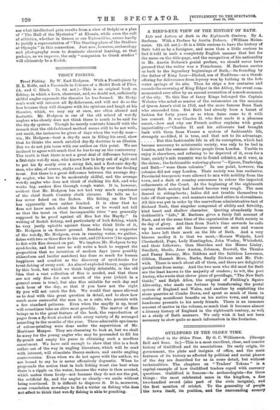Trout Fishing. By W. Earl Hodgson. With a Frontispiece by
H. L. Rolfe, and a Facsimile in Colours of a Model Book of Flies. (A. and C. Black. 7s. 6d. net.)—This is an original book on fishing, in which a keen, observant, and, we doubt not, sufficiently skilful angler expounds the theories he has formed. Mr. Hodg- son's work will interest all fly-fishermen, and will not do so the less because they will disagree with his opinions and laugh at his theories, which, we may say at once, are often absurd and fantastic. Mr. Hodgson is one of the old school of wet-fly anglers who clearly does not think there is much to be said for the dry-fly system. Though he merely contents himself with the remark that the old-fashioned method seems still to be not with. out merit, the instances he gives of days when the wet-fly man— viz., Mr. Hodgson—beat a dry-fly man in filling his creel, show that he thinks the much extolled dry-fly doctrine is an illusion. But we do not join issue with our author on this point. We are inclined to agree with much that he has to say on the controversy. The truth is that there is not a great deal of difference between a first-rate wet-fly man, who knows how to keep out of sight and to put his fly neatly over a rising fish, and a first-rate dry-fly man, who also, of course, stalks and floats his fly over the feeding -trout. But there is a great difference between the average dry-
ly angler, who has to be moderately skilful, and the average
wet-fly angler who does not think of stalking his fish, and who works big, sunken flies through rough water. It is, however, -evident that Mr. Hodgson has not had very much experience of the chief South Country chalk streams. He tells us he has never fished on the Itchen. His fishing on the Test has apparently been rather limited. It is clear that he Roes not know much about the Kennet, or he would not tell us that the trout on that incomparable river " are generally supposed to be proof against all flies but the Mayfly." In writing of Scotch fishing, and particularly of loch fishing, which he very justly upholds against those who think little of it, Mr. Hodgson is on firmer ground. Besides being a supporter of the wet-fly, Mr. Hodgson, even in running water, we gather, fishes with two or three flies to his cast, and (0 horror !) he appears to fish with flies dressed on gut. We implore Mr. Hodgson to try eyed-hooks, and feel sure he will write a book to support the proposition that no invention of modern days (save possibly chloroform and lucifer matches) has done so much for human happiness and comfort as the discovery of eyed-hooks for trout-fishing of every sort. A.3 almost exploded theory, supported by this book, but which we think highly debatable, is the old idea that a vast collection of flies is needed, and that there are not only flies for each month of the year (which in a general sense is true), but also flies suitable for each day and -each hour of the day, so that if you have not the right fly you will not catch the fish. We would that space allowed us to deal with this great question in detail, and to show how much more successful the man is, as a rule, who persists with a few standard patterns. Even when the mayfly is up, trout will sometimes take an olive most greedily. The matter of flies brings us to the great feature of the book, the reproduction of pages from a fly-book stocked with every variety of fly arranged according to the months of the year. These admirable specimens of colour-printing were done under the supervision of Mr. Mortimer Menpes. They are charming to look at, but we shall be sorry for the young angler who may be persuaded to fill his -fly-pouch and empty his purse in obtaining such a needless -assortment. We have said enough to show that this is a book rather out of the way in angling literature, which will be read with interest, will stimulate theory-makers, and excite angling controversies. Even when we do not agree with the author, we are bound to say he is never offensively dogmatic. When he propounds the notion that in loch fishing trout rise best when there is a ripple on the water, because the water is then aerated, which makes them lively—not because they do not see the gut, the artificial fly, and the angler so clearly—we smile without being convinced. It is difficult to disprove it. It is, moreover, some consolation nowadays to find a writer on fishing who does mot affect to think that wet-fly fishing is akin to poaching.


















































 Previous page
Previous page